
Himeji's glorious white castle is justifiably popular -- as a UNESCO World Heritage site, as a permanent feature on tourist brochures, and as an icon of Samurai films from Kurosawa (Ran) to Tom Cruise (The Last Samurai). And being only an hour from Osaka by train, it gets on the itinerary of most international and domestic tourists visiting the Kansai region.
The problem is, the Castle is so famous as a historical monument that it has become the only reason to visit for foreign tourists. From what I observe of fellow Gaijins, the typical itinerary seems to involve spending two hours touring the Castle (some even managed to drag around huge pieces of luggage in the process), then quickly leaving for the next destination. But with an entire day on our hands, we had a little more time to stumble into the Himeji that the locals know.
It's perfectly understandable why everyone just heads straight to the Castle -- it's the most impressive thing we saw emerging out of the train station, a perfectly white, stately architectural jewel standing only a kilometre away at the end of a wide boulevard (Otemae-dori). But we took the road less travelled ...

Actually it turned out to be the road most travelled, a crowded labyrinth of inter-connected covered arcades running the entire length of the Otemae-dori on the boulevard's right side. Only after returning to Canada did we find out that this was the main shopping district to the locals. You're less likely to encounter souvenir shops than some shoe store's liquidation sale (where my wife spent 30 minutes). We also bought some beautiful Furoshiki (Japanese handkerchiefs), a couple of cloth sacks, cosmetics and hair products, and some snacks and drinks along the way. It took us an hour just to get 500m closer to the Castle, but my wife really enjoyed it. A Japanese map of these shopping streets is here, but I would recommend doing this on the way back from the Castle, in case you find as many bargains as we did.
It was 11:30am by the time we finished shopping, so we decided to have lunch and recuperate a little before climbing the Castle.
Food Review: MATSUBISHI HONTEN (Himeji)
Address: Hyogo-ken Himeji-shi Fukunaka-machi 98
Hours: Thu-Tue, 11:30-13:45 and 16:30-21:30 (According to Gurunabi)
Website/Map: http://r.gnavi.co.jp/k030100/map1.htm
Directions: It took us 45 minutes of circling around the neighbourhood to find this place, so I'll give you the best directions I can. Take the North Exit from Himeji's JR Station. Walk straight towards the Castle on the left side of the main road (called Ootemae-dori). When you see the Yamato Yashiki department store on your right side across the street, walk to the end of that little block and immediately turn left into a small street. Walk straight for five blocks, and Matsubishi will be on your right hand side.

If I had done a little more homework beforehand and figured out the above directions for our own use, it would have taken 10 minutes instead of 45. I could have given up earlier, but this was supposed to be one of the premier restaurants focusing on Himeji's famous local catch, and I definitely didn't want to miss out.
To the Japanese, Himeji is not only synonymous with the Castle, but its Seto Naikai (Inland Sea) coast is also famous for producing Anago, the Japanese conger eel which is a summertime favorite in the Kansai region. We've had fresh Anago before in Tokyo (see review of Sushi Dai), but this is an old, renowned restaurant at the heart of the producing region, and we had correspondingly high expectations.
My first impressions of Matsubishi were the well-embellished interior, the 3000-8000 yen (CAD$30-$80) dinners courses, and the 1575 yen (CAD$16) lunch specials. So prices are fairly reasonable for lunch, and the choices were plenty:
- Anago-zushi Teishoku (Anago sushi set)
- Anago-don Teishoku (Anago ricebowl set)
- Tempura Teishoku
- Niku Amiyaki Teishoku (broiled pork on a wire mesh)
- Sashimi Teishoku
- Nigiri-zushi Teishoku (5 pieces of Anago sushi, plus 5 pieces of assorted)
We ordered Anago-don Teishoku and Anago-zushi Teishoku, as we were curious to find out how our chef would handle our theme ingredient in several different cooking methods. Well, it took about 30 minutes for our lunch to arrive even though we were the only table, so I guess our chef was taking the test seriously.
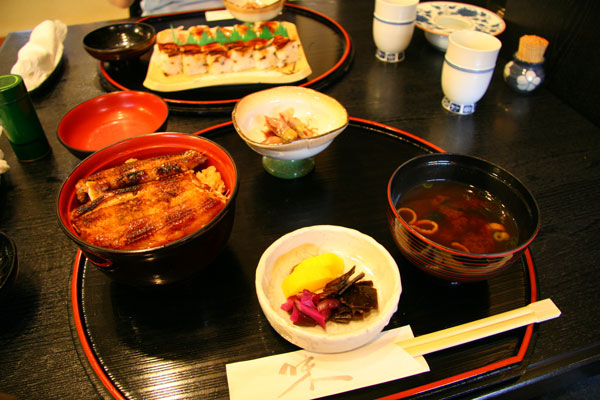
My Anago-don Teishoku arrived with an Aka-dashi soup, a salad with some mysterious little calamari, pickled vegetables, and a Yuzu (Japanese citrus) sorbet not shown in this photo. I remember the soup quite well -- it was a savory seafood-based (Anago bones perhaps?) broth with a strong red miso paste and garnished with strips of Anago. The pickles and sorbet weren't spectacular enough to stand out in my memory. But the true star of the meal arrived, accidentally, when I poped one of those little calamari into my mouth.
And it was an audible "pop" as the squid's tender body bursted under my bite and released a sweet, heavy paste. It's a velvety cream texture, but with a wonderful sweetness of shellfish and a hint of seawater. The squid body itself was roughly 5cm long, with little short tentacles, and very delicately steamed. So what is this dish called?
"Hotaru Ika no Sumiso-ae," or Firefly Squid with Vinegar-Miso Dressing, explained the Obasan who served us. Really? I had heard of Firefly Squids before, but mostly in a sightseeing context where people would take a night cruise in late spring and watch the sea turn into florescent blue. The Obasan continued to explain that the sweet paste was actually the roe, and that it was currently the best season (mid-May) as the mating squids were being fished out of the local waters. It was an unforgettable appetizer, and it would not be our last encounter with the Firefly Squid on this trip.
On to the main course ... what a disappointment it was, or at least MY main course was. I was hoping for a tender, moist fillet with a smoky tasting baste, but the result was just the exact opposite. I'm not saying it was a bad Anago-don -- I just happened to make the wrong choice for my own preference.

My wife's choice turned out much better -- six pieces of pressed Anago sushi, and four pieces of steamed Anago sushi. Her lunch set also came with the excellent Firefly Squids and the Aka-dashi soup, as well as the sorbet.
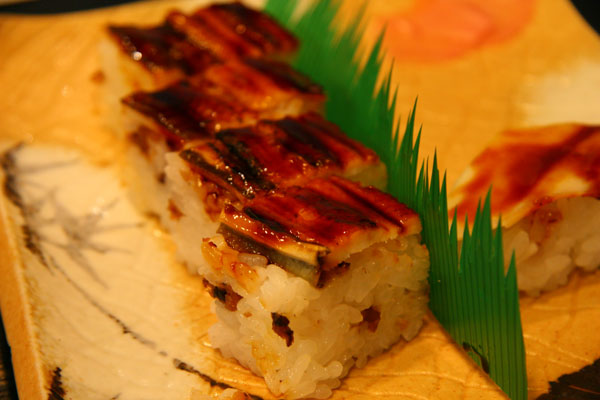
The lightly broiled Anago in the pressed sushi was better than my rubbery dry fillet, but to me the combination of broiling and the rich sauce entirely undermined the delicate flavor of the Anago. Again, it wasn't bad -- it was just not what I was looking for.

Wonder why there's only one piece left? Because this was by far the best of the three Anago preparations, and we almost finished it off before remembering to take a close-up photo. Initially plain-steamed without sauce, this Anago piece was unexpectedly firm and mild-tasting, with the light application of sauce complimenting rather than overpowering the subtle oiliness of the flesh. This was exactly the Anago I was looking for, but ... hey where did the rest go?
Bill for Two Persons
| Anago-don Teishoku | 1575 yen |
| Anago-zushi Teishoku | 1575 yen |
| TOTAL | 3150 yen (CAD$31) |
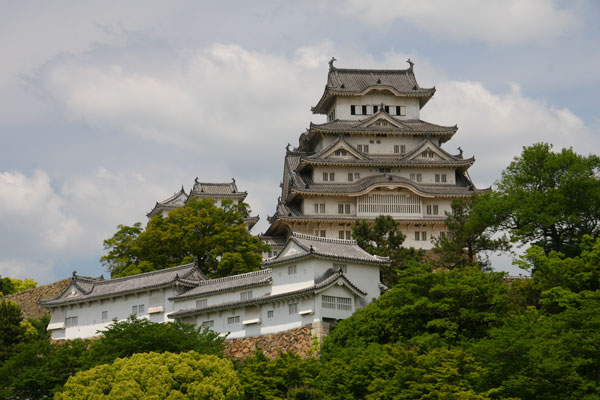
Time to begin the ascend. The magnificent Castle looked deceptively close, but like many medieval strongholds the approach was a winding maze of steps slowly climbing up the compound. In fact it took an hour and forty minutes to go from this picture to the top of the main tower, according to the timestamps.
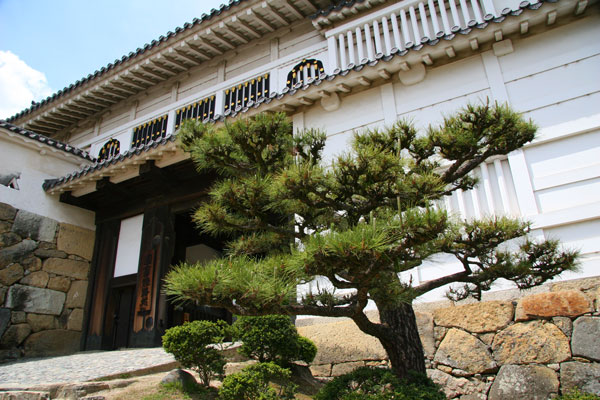
The seemingly rambling path was adorned with 400-year-old architecture and beautiful landscaping, belying its original purpose of misdirecting attackers.

Imagine you're a foot soldier in the Warring States period and you're climbing these long flights of steps in your 20kg armour suit, with arrows and musket fire raining down from above. Then you'll start to understand the value of the unusual defensive structures you come across on the way up. Heck ... I had a good workout myself even with a 2kg camera bag.

Finally a clear shot of the Tenshukaku (main tower). There's a REALLY interesting little semi-hidden courtyard nearby called the Harakiri-Maru, constructed with the sole purpose of providing the Master a secluded area for an undisturbed ritual suicide in a worst case scenario.
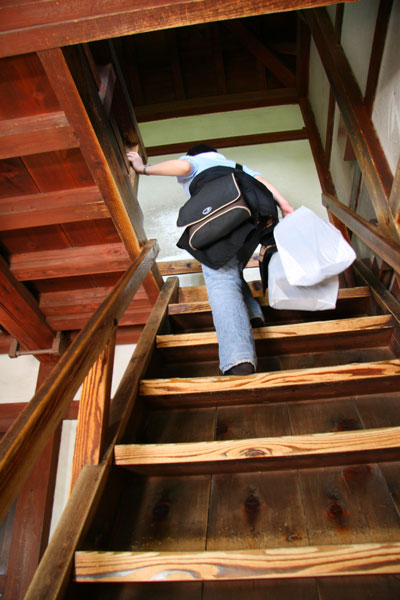
The interior is equipped with very steep stairs as you can see. Inside the white plastic bags are our own shoes, which must be removed prior to entering the interior of the Castle.
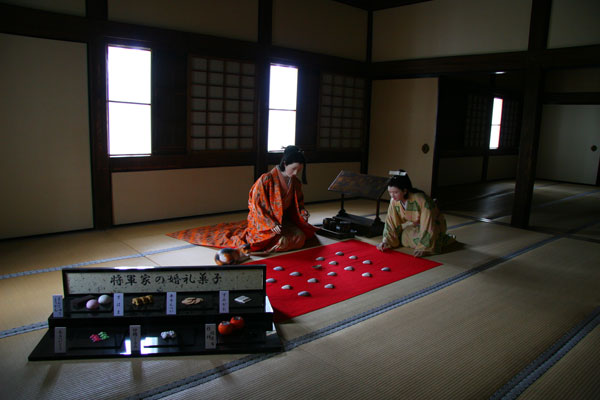
A life-size model of Sen-hime, a princess of the Shogun and a beloved historical figure, and the Wedding Desserts delivered to her husband Lord Honda Tadatoki by the Shogunate. Sen-hime was originally married to the Shogun's arch-enemy, and was remarried to Lord Honda after the Shogun defeated her first husband in battle and forced him to commit suicide. So you can imagine how this puppet princess was treated as a means of diplomacy in 17th century Japan.
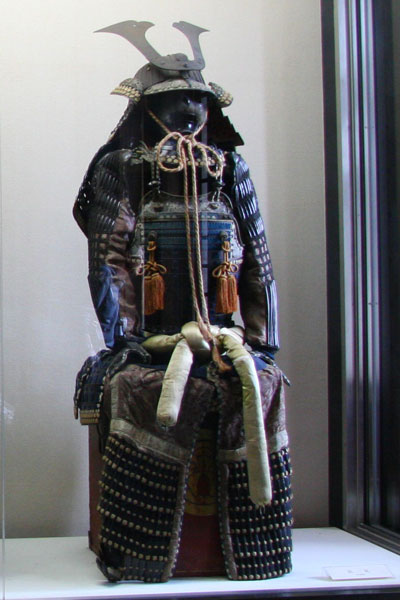
This is just a random shot of the hundreds of exhibits throughout the Castle. The exotic Samurai armour is actually not too dissimilar in principle to their European counterparts from the same period in history, except the use of muskets was only beginning in Japan and so the armours were still comparatively thinner and lighter.
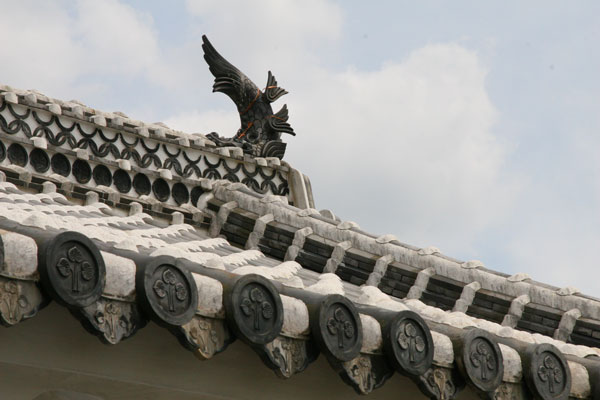
The killer whale talismans at the roof seems to be a typical feature of Edo period castles. Also note the Master's clan crest on the rounded "crest tiles" (Mongawara) -- the ownership of the Castle changed hands many times throughout history, and you can always associate a clan crest with its represented period of origin.
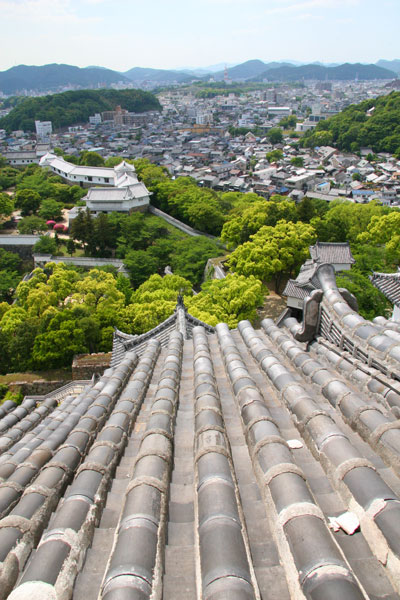
This is my favorite view from the top of the main tower, a westward view towards the rest of the castle compound and the town beyond. Not even a tall buildings in sight, so it wouldn't have been very different from the view Lord Honda woke up to nearly 400 years ago.

This is the southward view towards the Otemae-dori, with the JR station at the end of the boulevard.
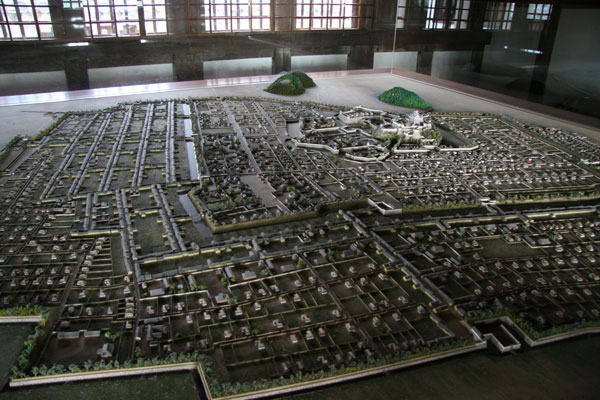
A model of the city of Himeji in the Edo period. Note the series of walls and moats that the potential attacker must breach even before reaching the Castle. The left edge of the picture is roughly where today's JR train station stands, so the entire walled area must have been two or three kilometres in diameter.

Adjoining the Castle on the southwest side is a relatively new (1992) Japanese garden called Koko-en, or Garden for Love of Antiquity ... well my translation anyway. If you've been to one of the more historic (and more lavish) Japanese gardens such as the Three Famous Gardens (located in Kanazawa, Okayama, and Mito), or if you have little interest in Japanese gardens, then I would recommend skipping this. Otherwise it's not a bad place to watch the colourful Koi fish and relax after a long hike up the Castle. The "combination ticket" for both the Garden and the Castle is just 100 yen more than a ticket to the Castle alone.
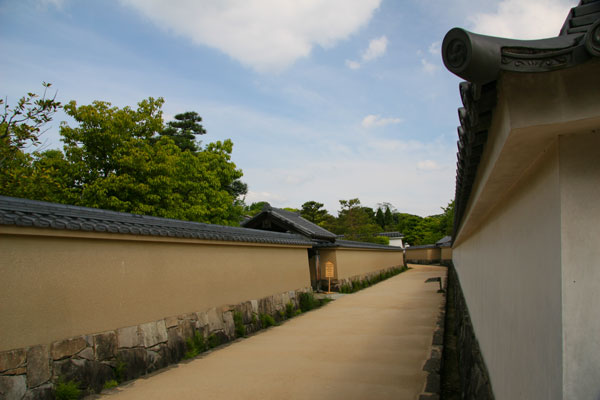
Built on top of an excavated site of former Samurai residences, the Garden fittingly reconstructed a series of beautiful earthen walled alleys, eerily similar to the Nagamachi samurai quarters of Kanazawa. The only clear giveaway hint of modernity is the perfect straight lines of the stone foundations.

A 100 yen (CAD$1) ride back to the JR station is a no-brainer at the end of a long day. The Loop Bus departs from the front of the Koko-en Garden once every 30 minutes.
Lastly, if you're planning to visit Himeji on a day trip from Osaka or Kyoto, I'd strongly recommend that you go to the nearest major JR station (eg.Kansai Airport, Osaka, Shin-Osaka, Kyoto) and get a JR-West Kansai Area Pass for 1 Day. It looks like this:

For 2000 yen (CAD$20), you get unlimited travel on any local and Kaisoku (fast) JR trains in the Kansai region from Nara to Kyoto to Osaka to Kobe to Himeji. Since a return trip from Osaka to Himeji costs about 2900 yen, you're getting a serious discount even if Himeji is your only destination of the day. Or if your hotel is in Kyoto, you're effectively getting 50% off regular fare. And if you're making a brief stop in Kobe for a steak dinner ... you get the idea.
Official site of the JR-West Kansai Area Pass is here.
Không có nhận xét nào:
Đăng nhận xét